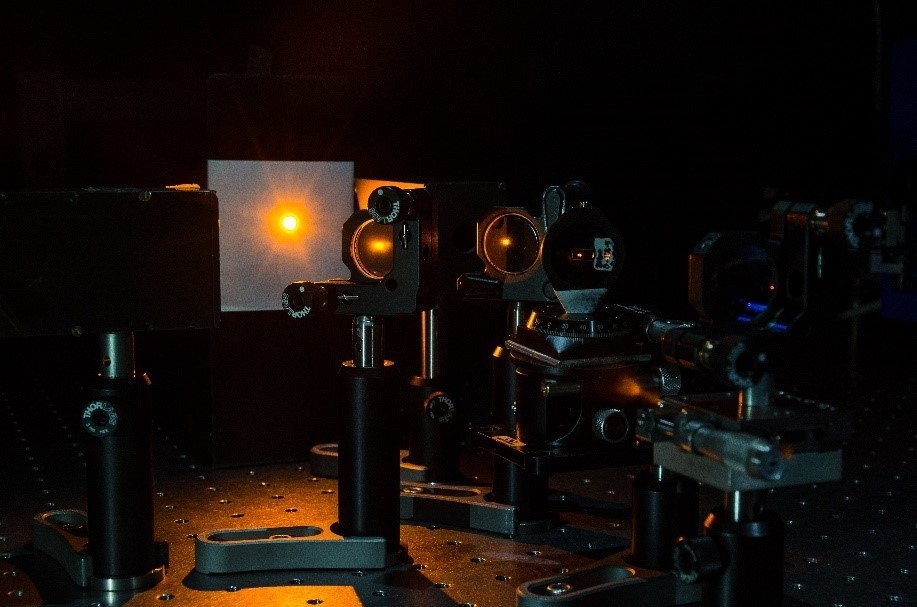Sep 10 2020
A group of scientists has recently designed an ultrafast, compact, high-power yellow laser. The new, tunable laser has superior beam quality and helps meet the requirement for a viable yellow light source that produces ultrafast light pulses.
 Researchers used a two-step nonlinear frequency conversion to convert mid-infrared laser light into yellow light that can be tuned from 570 nm to 596 nm. This wavelength range is useful for a variety of applications. Image Credit: Varun Sharma.
Researchers used a two-step nonlinear frequency conversion to convert mid-infrared laser light into yellow light that can be tuned from 570 nm to 596 nm. This wavelength range is useful for a variety of applications. Image Credit: Varun Sharma.
The yellow-orange spectral range is highly absorbed by hemoglobin in the blood, making lasers with these wavelengths particularly useful for biomedical applications, dermatology treatments and eye surgery. A femtosecond, tunable yellow laser source might one day offer medical treatments that produce less thermal damage and are more selective.
Anirban Ghosh, Study Team Member, Photonic Sciences Lab, Physical Research Laboratory
Building a Better Yellow Laser
Studies have already demonstrated that laser that emits in the yellow spectral range is ideal for numerous medical treatments, but such wavelengths are often produced using inefficient and large copper vapor lasers, optical parametric oscillators, and dye lasers.
While these sources of light have been effectively used in a range of applications, they have one or more disadvantages, for example, lack of excellent spatial beam profile, low average power, wide output pulses, and restricted or no wavelength tunability.
Femtosecond lasers are important for many applications because they emit a large number of photons in a short period to provide a very high intensity and extremely high precision without causing any thermal damage.
Anirban Ghosh, Study Team Member, Photonic Sciences Lab, Physical Research Laboratory
Ghosh continued, “However, there is no commercially available femtosecond yellow laser that can provide all the desired parameters needed for the applications that would benefit from this wavelength range.”
Therefore, to deal with these restrictions in a solo experimental configuration, the team utilized a newly designed ultrafast solid-state Cr2+:ZnS laser that emits in the mid-infrared range together with a two-stage frequency-doubling procedure.
But frequency doubling of an ultrafast laser is a complicated procedure and involves the detection of the right kind of crystal to create a quality laser output that has the required characteristics.
We frequency-doubled the ultrafast mid-infrared laser with a peak wavelength at 2360 nm in two different nonlinear crystals and used simple optical components available in any standard optics laboratory to achieve high power, tunable, ultrafast yellow laser source.
Anirban Ghosh, Study Team Member, Photonic Sciences Lab, Physical Research Laboratory
“As a byproduct, our source provides tunable ultrafast near-infrared radiation with substantial average power useful for various fields, including spectroscopy, material processing and imaging,” added Ghosh.
The new laser was subjected to tests that showed that it could offer the highest output average power of more than 1 W, with 130 fs pulses at a repetition rate of 80 MHz along with an excellent spatial beam profile. The team also noted exceptional power stability across a long period.
The investigators intend to further enhance the compactness, efficiency, and pulse duration of the new laser. They are also exploring ways to improve the laser so that it can work at room temperature to render it more viable for durable use.
Journal Reference:
Yadav, D., et al. (2020) Watt-level, ultrafast, tunable yellow source based on single-pass, fourth harmonic generation of Cr2+:ZnS laser at 2360 nm. Optics Letters. doi.org/10.1364/OL.404358.